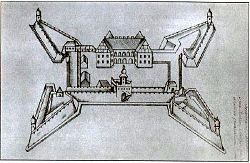Lachovice
|
Liachavičy Ляхавічы |
||
|---|---|---|

Liahavichy Castle in the 17th century
|
||
|
||
| Coordinates: 53°02′N 26°16′E / 53.033°N 26.267°E | ||
| Country |
|
|
| Voblast | Brest Voblast | |
| Raion | Lyakhavichy Raion | |
| Mentioned | 1572 | |
| City status | 1931 | |
| Elevation | 180 m (590 ft) | |
| Population (2008) | ||
| • Total | 10,997 | |
| Time zone | EET (UTC+2) | |
| • Summer (DST) | EEST (UTC+3) | |
| Postal code | 225372 | |
| Area code(s) | (+375) 1633 | |
| Vehicle registration | 1 | |
| Website | liahovichi.brest-region.by | |
Liachavičy (Belarusian: Ляхавічы, pronounced [ˈlʲaxavʲitʂɨ], Russian: Ляховичи, Polish: Lachowicze, Yiddish: לעכאוויטש Lekhavitsh, Lithuanian: Liachivičai) is a city in the southwestern Belarusian voblast (province) of Brest.
For many centuries, it was part of the Grand Duchy of Lithuania. The city's fortress, Liachavičy Castle, survived all sieges during the Russo–Polish War (1654–1667), and was nicknamed the Jasna Góra of Lithuania.
During World War II, Liachavičy was under German occupation from 26 June 1941 to 5 July 1944. More than 3,000 Jewish inhabitants lived in the town, swelled by an influx of refugees fleeing from central and western Poland. In November, 1941, Jews were gathered in the central square, then taken and killed in a sand pit near the village of Lotva by an Einsatzgruppe. A new massacre took place in June 1942 when 300 Jews kept prisoners in a ghetto were killed in a place close to the previous one. That day, a revolt in the ghetto took place and several Jews managed to join the partisans.
Coordinates: 53°02′N 26°16′E / 53.033°N 26.267°E
...
Wikipedia


